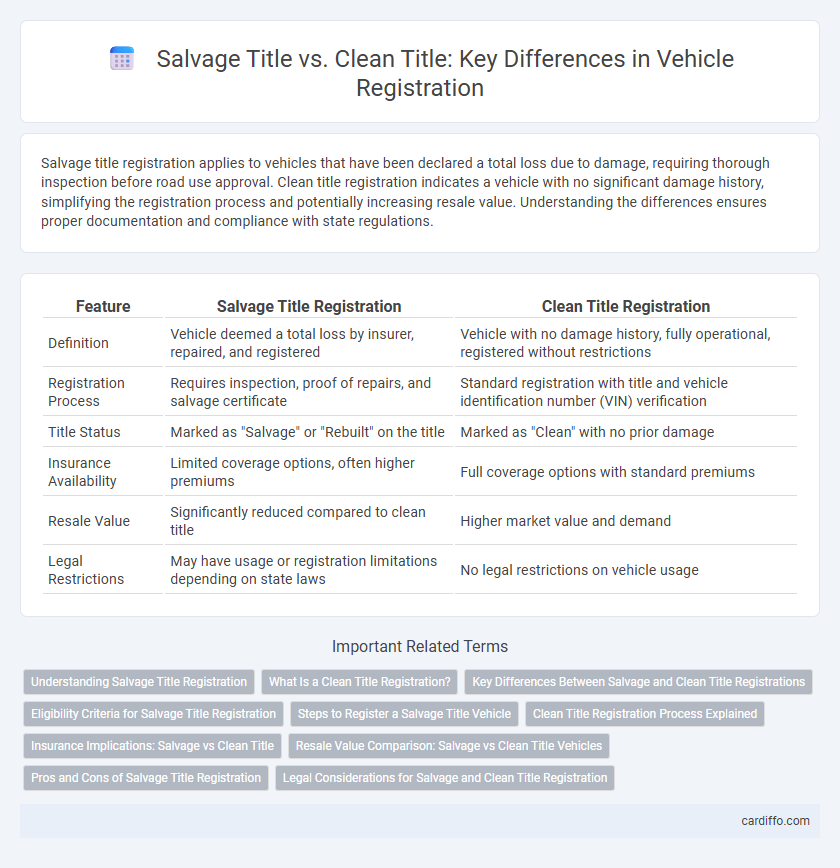Salvage title registration applies to vehicles that have been declared a total loss due to damage, requiring thorough inspection before road use approval. Clean title registration indicates a vehicle with no significant damage history, simplifying the registration process and potentially increasing resale value. Understanding the differences ensures proper documentation and compliance with state regulations.
Table of Comparison
| Feature | Salvage Title Registration | Clean Title Registration |
|---|---|---|
| Definition | Vehicle deemed a total loss by insurer, repaired, and registered | Vehicle with no damage history, fully operational, registered without restrictions |
| Registration Process | Requires inspection, proof of repairs, and salvage certificate | Standard registration with title and vehicle identification number (VIN) verification |
| Title Status | Marked as "Salvage" or "Rebuilt" on the title | Marked as "Clean" with no prior damage |
| Insurance Availability | Limited coverage options, often higher premiums | Full coverage options with standard premiums |
| Resale Value | Significantly reduced compared to clean title | Higher market value and demand |
| Legal Restrictions | May have usage or registration limitations depending on state laws | No legal restrictions on vehicle usage |
Understanding Salvage Title Registration
Salvage title registration applies to vehicles damaged in accidents, floods, or thefts and subsequently deemed a total loss by insurance companies, reflecting their reduced value and potential safety issues. Registering a salvage title involves specific inspections and paperwork to verify the vehicle meets state safety standards before road use. This process contrasts with clean title registration, where the vehicle has no significant damage history and generally requires standard documentation for ownership transfer.
What Is a Clean Title Registration?
A clean title registration indicates that a vehicle has never been severely damaged, salvaged, or declared a total loss by an insurance company. This type of title signifies clear ownership and ensures the car meets all safety and legal standards without any history of major accidents or repairs. Registering a vehicle with a clean title typically leads to higher resale value and easier financing options compared to salvage title registration.
Key Differences Between Salvage and Clean Title Registrations
Salvage title registration indicates a vehicle has been significantly damaged or deemed a total loss by an insurance company, affecting its resale value and requiring inspection before it can be driven legally. Clean title registration confirms the vehicle has no major damage history, making it easier to insure, finance, and sell without restrictions. Understanding these differences helps buyers and sellers assess vehicle condition, legal status, and potential repair costs accurately during the registration process.
Eligibility Criteria for Salvage Title Registration
Salvage title registration eligibility requires a vehicle to have sustained significant damage, often declared a total loss by an insurance company due to accidents, floods, or theft recovery. The vehicle must pass state-specific inspections to ensure it meets safety standards before the salvage title can be issued. Clean title registration, in contrast, applies only to vehicles with no history of major damage or total loss declarations.
Steps to Register a Salvage Title Vehicle
Registering a salvage title vehicle requires obtaining a salvage certificate, completing a thorough vehicle inspection to verify repairs and safety compliance, and submitting the necessary paperwork, including the salvage certificate and proof of ownership, to the Department of Motor Vehicles (DMV). After passing the inspection, the vehicle owner must fill out the application for a rebuilt or salvage title and pay the applicable fees. This process ensures that the vehicle, previously deemed a total loss, meets state safety standards before being legally registered.
Clean Title Registration Process Explained
Clean title registration involves submitting proof of vehicle ownership, such as a Manufacturer's Certificate of Origin or previous clean title, along with completing a vehicle inspection and paying applicable registration fees. This process ensures the vehicle has never been declared a total loss or had significant damage, providing buyers with assurance of its condition. Clean title registration typically requires valid identification, proof of insurance, and passing any required emissions or safety tests.
Insurance Implications: Salvage vs Clean Title
Salvage title registration often leads to higher insurance premiums or limited coverage options due to the vehicle's history of severe damage or being declared a total loss. Clean title registration indicates no significant damage history, resulting in standard insurance rates and comprehensive coverage availability. Insurance companies assess risk based on title status, making salvage-titled vehicles more costly and harder to insure compared to clean-titled vehicles.
Resale Value Comparison: Salvage vs Clean Title Vehicles
Vehicles with clean title registration typically maintain higher resale value compared to salvage title vehicles, which often suffer significant depreciation due to their accident or damage history. Salvage title registration signals potential buyers about prior severe damage, reducing market demand and competitive pricing. Clean title vehicles offer greater assurance of reliability and condition, making them more attractive and valuable in the resale market.
Pros and Cons of Salvage Title Registration
Salvage title registration allows vehicles that have been declared a total loss by insurance to be legally driven again after repairs, often resulting in lower purchase prices compared to clean title cars. However, salvage title vehicles typically face reduced resale value, higher insurance premiums, and potential difficulties in obtaining financing due to perceived risks and prior damage history. Despite cost savings upfront, buyers should weigh the trade-offs in reliability, safety, and marketability when considering salvage title registration.
Legal Considerations for Salvage and Clean Title Registration
Salvage title registration involves strict legal requirements, including detailed documentation of damage and proof of repairs to ensure the vehicle meets safety standards, while clean title registration typically requires standard ownership documents without damage disclosures. Legal considerations for salvage titles often include limitations on resale, insurance restrictions, and mandatory inspections before registration approval. Clean title vehicles generally face fewer legal hurdles, allowing smoother transfer of ownership and broader market acceptance.
Salvage Title Registration vs Clean Title Registration Infographic

 cardiffo.com
cardiffo.com